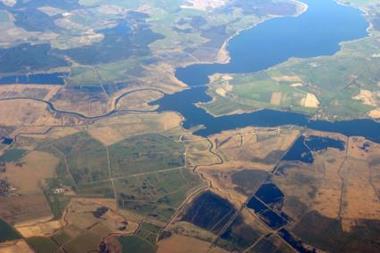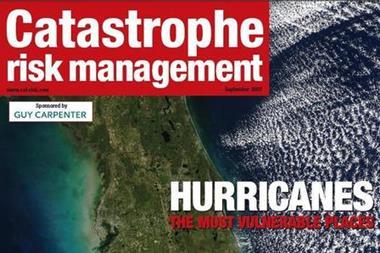Some 30% of businesses worldwide have some direct exposure to weather related risks and 60% have indirect exposure. By Jean-Christophe Garaix
Hot soup does not sell in a heat wave. Ice cream is hard to shift when the sun fails to shine. A hot summer may turn our thoughts to a cold beer. This would be trivial if it were the casual inclination of a single individual. But brewers benefit when a million others feel the same way. On the other hand, if the summer is cool, beer sales will slump. Weather has a direct and predictable influence on human behaviour.
In a less financially focused age, a beer company's shareholders might have shrugged phlegmatically and blamed the weather. Today, poor results lead to plummeting stock prices and rolling heads. If financial planners and risk managers fail to allow adequate means to cope with weather variations in this business climate, they will provoke a very unpleasant reaction from shareholders and analysts.
A growing awareness of how weather conditions affect the fortunes of companies worldwide only began to translate into attempted precautionary measures in the last few years. Energy companies are among those most affected by fluctuations in the weather and, more specifically, the temperature. Individuals and industrial customers will buy less fuel to heat their homes and premises when temperatures stay high throughout the winter. At the opposite end of the scale, more power will be required for air conditioning if summer months are hot in regions such as the United States, Australia and the Far East.
Weather risk management
The weather risk management market took its first steps in 1997 when US energy companies began swapping their regional exposures in an attempt to balance their temperature dependent financial risks. To keen minds, this soon suggested that profits could be derived from such transactions on a broader scale. It also suggested a significant requirement for capacity. This subsequently attracted the interest of the traditional providers of risk capital: reinsurers.
One of the main differences between weather risks contracts and traditional insurance or reinsurance is that there is never any doubt about whether or not cover has been triggered. This is because it is contractually based on an index of data supplied by a neutral third party, such as the National Weather Service, the Met office or Météo France. Payment is based unequivocally on a pre-agreed financial formula, not on the indemnification principle.
Clustered claims
Risk carriers face unprecedented exposures. Extraordinary climatic conditions in any region are likely to trigger claims widely. The potential for resulting accumulations is a sobering prospect to contemplate for even the least risk adverse markets. This scenario raises the spectre of a total loss of investment when capital market players are involved. Such volatile business demands massive surpluses.
To generate a book of business that is balanced, therefore, this type of risk must be written on a truly global basis. Even then, out of respect for such transcontinental phenomena as El Niño and La Niña, it can only be written on the basis of a detailed and precise understanding of the nature of the risk assumed. Furthermore, in the last decade, weather science has increasingly demonstrated interdependency between phenomena.
The weather market has generated a lot of interest in all ways- unsurprisingly when you consider that up to 30% of businesses around the world have some direct exposure to weather related risks (and 60% indirect exposure)- but it has been remarkably slow to take off among businesses other than the energy sector.
Energy companies in the United States, Europe and Japan, who are still the most active participants on this market (a secondary market), contributed to a large extent to the explosive growth in the weather futures market. The Chicago Mercantile Exchange announced that $45 billion flowed through weather market between April 2005 to March 2006, more than five times the previous year. Most of this volume is traded on US weather stations and temperature indices.
But there is, undoubtedly, a potentially huge market for other sectors in future - from which will emerge new and powerful approaches to risk transfer and risk management.
Consider just a few of the possible purchasers:
* Leisure parks looking for protection against attendances due to poor weather
* Construction companies covering themselves against frozen watercourses
* Clothing manufacturers looking for a hedge against unseasonable conditions that could adversely affect sales
* Local authorities wishing to hedge against snow removal costs
The list can - and will - be extended indefinitely. There is also a massive potential need for weather-proof products and services from specific companies. Leisure and travel companies, for example, could offer free travel arrangements to skiers whose holidays were spoiled by lack of snow.
Agriculture covers
One of the most promising sectors is agriculture. More and more farmers are looking for cover against adverse growing conditions. Traditional insurance is not able in many cases to respond with multi-peril yield covers. For some crops, loss adjustment is too difficult. In some developing countries, insurance is not widely enough spread to provide insurance policies for local farmers.
In these cases, index based solutions seem the best way to guarantee a minimum yield for the crop. The main issue is to define the index that will be the best proxy of local yields. Three types of approaches are possible:
* Weather index based solution with temperature and/or precipitation indices.
* Normalised difference vegetation index (NDVI) when payment is a function of a proxy of the bio-mass index and not directly of a weather index. Crops have a specific NDVI range which can be compared to the effective NDVI given by satellite.
* Yield index. The yield index provided by a third party, an agricultural ministry for example for a specific crop and county, is the best proxy of the farmers' results. This type of cover avoids moral hazard and claims management.
It is not only companies and farmers that are concerned by such exposure. New sectors, such as humanitarian organisations, can find support from weather risk transfer solutions. The World Food Program, the food aid organisation of the United Nations, has studied a pilot project to contribute to a pre-event risk management system to protect the livelihoods of Ethiopian farmers vulnerable to severe and catastrophic weather risks.
The main point of the study was to use a derivative to demonstrate the feasibility of establishing contingency funding for an effective aid response in the event of contractually specified severe shortfalls in rain. The World Food Program put the pilot project in place for the world's first humanitarian insurance policy with AXA RE (now Paris RE) as counterparty, to cover a small part of Ethiopia's agricultural season between March and October 2006. In the event, 2006 was not a drought year, but had the coverage been triggered, the insurance would have got emergency money flowing before images of dying babies reached televisions screens.
This experience is now being extended to other African countries and to other parts of the world, such as Central America, for protection against excess rain.
All these examples show the potential for growth of the weather market, which will reach maturity and achieve its full potential once the right way has been found to assume and manage this type of exposure. Secondary market development, hedge funds entering this market, and the re/insurance involvement will then play a major role.
Postscript
Jean-Christophe Garaix is class manager weather and agricultural risks at Paris Re.
Email: jeanchristophe.garaix@paris-re.com
Website: www.paris-re.com



















No comments yet